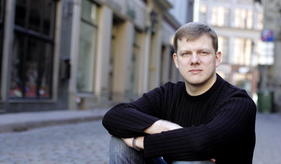Three motets for Passion Sunday
In Mozart’s day, church music was not composed with concert performance in mind. Masses, vespers, requiems, passions-- all were composed for use in divine worship; divisions into separate sections, internal beginnings and endings, corresponded to the texts, which had specific functions in their respective liturgical observances. Composers were not thinking in terms of “movements” as we know them today; nor were they composing large-scale works which would take up an acceptable and convenient concert-length amount of time. Mozart’s Requiem is no different. Depending on the completion utilized, a complete performance, without inclusion of any extra-Mozartian liturgical materials, lasts between forty and fifty minutes. Modern audiences expect a somewhat longer concert; so the Requiem is usually paired with other, shorter works, sometimes by Mozart, sometimes not. Chorale has chosen to sing three a cappella motets by modern composers, settings of texts appropriate to Holy Week, which have a musical and acoustical character particularly appropriate to St.Benedict’s Catholic Church, the venue for our concert.

Two of these motets are by Knut Nystedt, who spent most of his life in Oslo, Norway, where he was organist at Torshov Church and taught choral conducting at the University of Oslo. He also founded the Norwegian Soloists' Choir and conducted it for forty years. But he is most recognized for his choral compositions, which are mainly based on texts from the Bible or sacred themes. Chorale presents two of his best-known works tonight. In Immortal Bach he instructs the choir to surround the concert hall in a single line, divided into five separate choirs, and sing the first eight bars of J.S. Bach’s setting of the chorale “Komm, süßer Tod;” then, through strict rhythmic augmentation and the resultant harmonic overlapping of the melody and harmony in the further course of the work, he creates a soundscape reflecting the eternal value of Bach’s music, as well as Bach’s Christian view of immortality. “O crux” sets a meditation on the cross by Venantius Fortunatus, 6th century poet, priest and Bishop of Poitiers, and is Nysted’s most beloved and performed work, especially during the Triduum, the three days between Maundy Thursday and Easter Sunday in Western Christianity. Nystedt explores the widest possible range in volume, pitch, and harmonic density, alternating between dissonant polyphony and rich, diatonic block chords, in expressing the pain and ecstasy of the crucifixion.
Our third motet is by Latvian composer Ēriks Ešenvalds, one of the most performed choral musicians working today. His complex, multilayered compositions, sometimes in eight or even sixteen parts, currently enjoy enormous popularity with choirs all over the world, with their rich, diatonic tonal color and lyrical melodic lines. He has a very busy schedule of commissions and public appearances, in addition to teaching composition at the Latvian Academy of Music. O salutaris hostia, a gentle setting of a portion of a eucharistic hymn by Thomas Aquinas (1255-1274), is one of Ešenvalds’ most successful pieces. Originally composed for female voices, the version for full choir Chorale will sing was completed in 2009. Two soprano soloists share the melodic material over a hushed accompaniment for full choir, alternately imitating and echoing each other.
We expect that the inclusion of these pieces on our program will not only enrich the listening experience for our audience, but will set Mozart’s very special, eighteenth century art in bold relief, against music composed two hundred year later, in a much different world.

